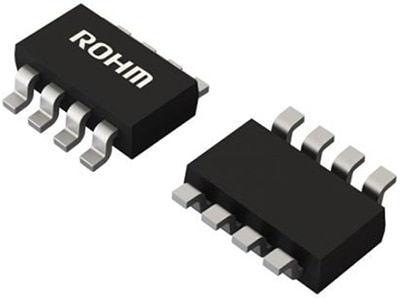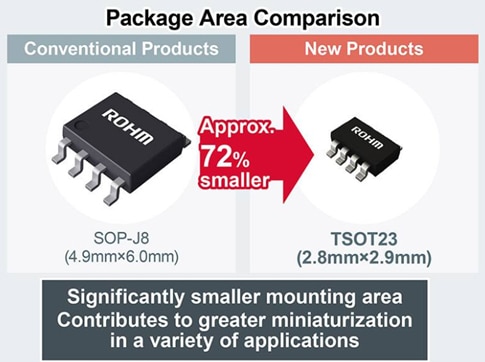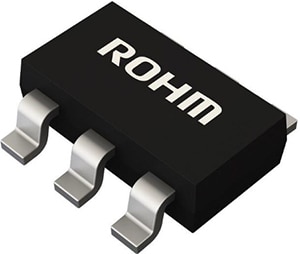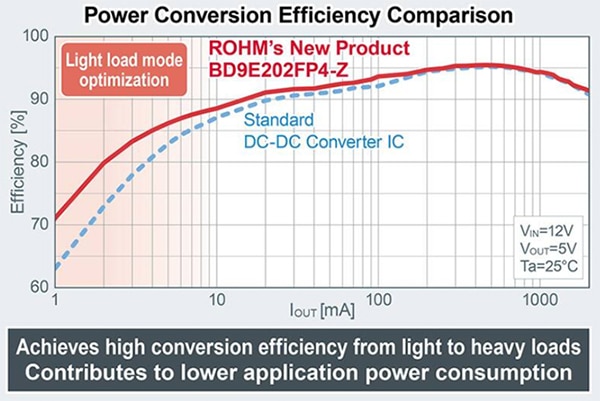使用正确的开关稳压器提高效率
投稿人:DigiKey 北美编辑
2025-01-07
选择合适的开关稳压器时,效率是最重要的选择依据。当今的微型设备应能以较小的尺寸实现可靠的电源。
能够通过产生稳定的电压来提供大量电流,是电子器件设计的一项基本要求。开关稳压器是产生稳定的电源电压和将电压升高或降低的必备器件。
开关稳压器有多种名称:转换器或开关、开关模式电源 (SMPS) 以及 DC/DC 稳压器或转换器。由于在满足更高效的高功率转换要求、能灵活地从单输入电压源获得稳定输出以及能适应不同极性的多路输出电压等方面具有优势,开关稳压器的受欢迎程度在持续上升。
最常见的开关转换器类型如下:
- 升压型:将输入电压升高,并在调节后输出
- 降压型:将输入电压降低,并在调节后输出
- 升降压:将输入电压升高或降低,可选择负极性
- 反激型:一种同时提供电隔离的升降压类型
恒压和可调节线性电压稳压器
多年来,电源设计一直依赖线性稳压器。事实证明,线性稳压器在提供连续的固定输出电压方面表现出色。除此之外,还有其他线性稳压器(如 LM317)具有调节功能。
常见的恒定和线性输出电压稳压器类型包括 78xx 正输出系列、79xx 负输出电压系列。这类稳压器可提供 5 V 至 24 V 的稳定输出。
线性稳压器不是开关模式电源。稳压器的优点是结构简单、成本低。稳压器的输出功率通常低于 10 W 且效率往往较低,因此会发热,但具有低噪音和低纹波特性。线性稳压器只能进行降压调节,而 SMPS 则可以利用降压、升降压器件对输入电压进行电压升高、降低和负向调节。
开关模式电源系统
大多数现代电视机、个人电脑、直流电机驱动器和功率放大器都需要先进高效的 SMPS 器件。这种器件利用半导体开关技术而不是标准的线性方法来提供输出电压。基本的开关转换器由功率开关级和控制电路组成。
SMPS 的功率耗散较低,通过在饱和“导通”和截止“关断”状态之间在内部对晶体管(或功率 MOSFET)进行开关操作,拥有了效率更高的优势。
降压开关稳压器
ROHM Semiconductor 的 BD9x 系列为设计人员提供了高效率 DC/DC 降压转换器,是需要高效率电源转换应用(包括汽车和工业设计)的紧凑型选择。BD9x 系列采用简化设计,减少了器件数量,从而节省了空间、减少了制造流程。该系列待机电流小,可延长便携式应用中的电池寿命,同时保持稳定的输出电压,以实现可靠的性能,例如 BD9A201FP4-LBZTL降压型开关稳压器(图 1)。
 图 1:BD9A201FP4-LBZTL 降压型开关稳压器可提供稳定的输出电压。(图片来源:ROHM Semiconductor)
图 1:BD9A201FP4-LBZTL 降压型开关稳压器可提供稳定的输出电压。(图片来源:ROHM Semiconductor)
BD9E105FP4-ZTL 降压型开关稳压器(图 2)提供单路可调输出,是一款专为满足较低电压需求而设计的直流稳压器。凭借低导通电阻功率 MOSFET 和单同步降压 DC/DC 转换器,BD9E105FP4-ZTL 稳压器在轻负载条件下可实现最佳能效。这非常适合要求待机功耗最小的设备和装置。
该器件不仅瞬态响应特性良好,在电路板上的占用面积小,而且封装小巧、功率密度高,是冰箱和空调等家电产品、电信设备、适配器和二次电源设备的理想之选。
 图 2:BD9E105FP4-ZTL 降压型开关稳压器可满足较低的电压需求。(图片来源:ROHM Semiconductor)
图 2:BD9E105FP4-ZTL 降压型开关稳压器可满足较低的电压需求。(图片来源:ROHM Semiconductor)
升压开关稳压器
MP3414AGJ-Z 升压开关稳压器提供可调输出,其外形纤薄,适合空间有限的表面贴装应用。该器件能在 -40°C ~ +125°C 的温度范围内轻松运行,并能从低至 1.8 V 的输入电压开始工作,同时提供浪涌电流和输出短路保护 (SCP)。
当需要具有输出断开功能的升压转换器时,必须能在保持高效率的同时以同步电流模式运行。此外,由于采用集成 P 沟道同步整流器提升了效率,因此无需外部肖特基二极管。MP3414A 关断时的输出断开功能可实现完全放电,同时在关断模式下的电流消耗小于 1 μA。
越小越好
使用 MP3414A 可以减少外部元件数量。该器件具有 1 MHz 开关频率,可使用小体积外部元件,同时其软启动功能最大限度地减少了外部元件数量。该器件可处理较大范围的电流负载。此外,集成功率 MOSFET 支持超过 3 A 的峰值开关电流,且输出电压达到 5.5 V。
这种多用途、大功率和小巧的外形非常适合此类单芯锂电池产品,包括两芯和三芯碱性、镍氢或镍镉电池。诸如 MP3414A 这样的升压转换器非常有助于无线外设、游戏配件、个人医疗设备和便携式媒体播放器。
这种技术发展迅速,而且产品外形越来越紧凑。与 SOP-J8 相比,采用 TSOT23 封装的 MP3414AGJ-Z 体积缩小了约 72%,从而大大减少了所需的板面积(图 3)。
 图 3:随着元器件的设计越来越小,封装(如 TSOT23)小型化就显得非常必要。(图片来源:ROHM Semiconductor)
图 3:随着元器件的设计越来越小,封装(如 TSOT23)小型化就显得非常必要。(图片来源:ROHM Semiconductor)
降低功耗的同时,最大限度地提高效率
对小型化的需求是一种持续驱动力;同时,还需要保持可靠性和功率效率。BD9E202FP4-ZTL 降压型开关稳压器设计紧凑,提供可调输出和可靠的功率(图 4)。
 图 4:BD9E202FP4-ZTL 是一款降压型开关稳压器,能以更小巧、更紧凑的设计可靠地输出功率。(图片来源:ROHM Semiconductor)
图 4:BD9E202FP4-ZTL 是一款降压型开关稳压器,能以更小巧、更紧凑的设计可靠地输出功率。(图片来源:ROHM Semiconductor)
也许有人认为,小型化意味着以牺牲负载能力或可靠的电力输送为代价,但事实并非如此。 BD9E202FP4-ZTL 不仅实现了高转换效率,而且还有助于降低功耗要求(图 5)。
通过提供较低的待机电流,电池供电型设备可将闲置时的功耗降至最低。此外,通过控制恒定导通时间,还可实现高效的轻负载运行。
 图 5:设计人员正在寻找能够高效、可靠供电的高能效 DC/DC 降压转换器。(图片来源:ROHM Semiconductor)
图 5:设计人员正在寻找能够高效、可靠供电的高能效 DC/DC 降压转换器。(图片来源:ROHM Semiconductor)
用于 AC/DC 和 DC/DC 的反激式转换器
反激式转换器是一种包含反激式变压器的升降压转换器。既可用于 AC/DC 转换,也可用于 DC/DC 转换,且在任何输出与输入之间都实现了电隔离。此外,还具有电压比倍增功能,以及隔离的额外优势。
隔离式电源转换器有两种控制方案:电压模式控制和电流模式控制。为确保运行时的稳定,大多数情况下电流模式控制应占主导地位。
升降压型 DC/DC 转换器
升降压转换器是一种典型的 DC/DC 转换器,其输出电压幅值大于或小于输入电压。此外,这种转换器也可以产生负电压。这种转换器类似于反激式转换器,但不使用变压器,而是使用单个电感器。具体来说,升降压转换器由两种不同的拓扑结构组成,都能产生从大于输入电压到小至零的一系列输出电压。
DC/DC 电源有时被称为“斩波器”,包括一个升降压电路,可根据占空比的不同,用作升压或降压转换器。
结语
当今汽车和工业设计的高效电源转换离不开开关稳压器。随着当今的设计变得越来越紧凑小巧,对能够保持稳定功率水平的多功能高效器件的需求也空前高涨。
虽然开关稳压器可能有不同的名称——SMPS、DC/DC 转换开关、稳压器或转换器,但 ROHM 可为需要高效电源转换的各种应用提供多种紧凑型产品选择。

免责声明:各个作者和/或论坛参与者在本网站发表的观点、看法和意见不代表 DigiKey 的观点、看法和意见,也不代表 DigiKey 官方政策。






